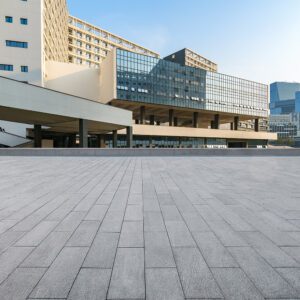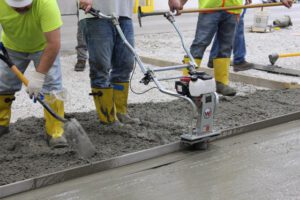White Concrete: Everything You Need To Know
White concrete flooring is gaining popularity in residential, commercial, and industrial spaces due to its durability, ease of maintenance, and unique aesthetic appeal. This comprehensive guide will explore the process of creating white concrete, its benefits and drawbacks, and how to ensure a high-quality finish.
The History of White Concrete
White concrete has become an increasingly popular choice in architecture and interior design over the past few decades. Its history can be traced back to Europe in the early 2000s, where architects and designers began experimenting with new techniques and materials to create unique and visually striking structures.
One of the key advantages of white concrete is its versatility in colour. Unlike traditional grey concrete, which can look dull and utilitarian, white concrete offers a range of shades, from off-white to pale yellows and greens. This range of colours has made it a popular choice for everything from modernist homes to sleek, contemporary commercial buildings.
As white concrete has gained popularity, designers and architects have continued to push the boundaries of what’s possible with the material. Today, white concrete can be found in a wide variety of applications, from polished floors and countertops to intricate facades and sculptural installations. Whether you’re looking to create a minimalist interior or a bold, statement-making exterior, white concrete offers endless possibilities for design.
What are the uses of white concrete?
White concrete is suitable for both indoor and outdoor applications in residential, commercial, and industrial spaces. Its durability, ease of cleaning, and strength make it ideal for high-traffic areas, offering an affordable alternative to other flooring materials like tiles or wood.
The Benefits of White Concrete
In addition to its aesthetic appeal, white concrete offers a range of practical benefits, making it an excellent choice for a wide range of applications.
Easy maintenance and cleaning: Despite its white surface, the high-gloss finish on polished concrete is resistant to stains and spills, making it a practical choice for busy areas such as hallways or kitchens.
Durability: Unlike softer polished floors like marble or granite, which can chip over time, white concrete is less susceptible to damage, requiring less maintenance throughout its lifetime.
Are There Any Drawbacks to White Concrete?
While white concrete offers a range of benefits, there are also some drawbacks to consider when selecting this material for your space.
White concrete requires more frequent cleaning than unsealed concrete, with regular sweeping or vacuuming necessary to maintain its appearance. Any spills or stains should be cleaned up promptly to prevent staining, and the surface may require occasional resealing to maintain its shine. This increased maintenance can be a drawback for those looking for a low-maintenance flooring option.
In addition, due to its polished finish, white concrete can be more slippery than unsealed concrete, especially when wet. This can be a concern in areas that are prone to spills or moisture, such as kitchens, bathrooms, or pool decks. While non-slip additives can be added to the surface to improve traction, this can impact the appearance of the concrete and may not be suitable for all applications.
Despite these drawbacks, white concrete remains a popular choice for its versatility, durability, and aesthetic appeal. By carefully considering the specific needs of your space, you can determine whether the benefits of white concrete outweigh the potential drawbacks for your project.
How is White Concrete Created?
White concrete is created by combining several key ingredients, including cement, water, and aggregates such as sand and gravel. To create a white finish, special pigments or other additives are often included in the mix.
The first step in creating white concrete is to combine the dry ingredients in a large mixer, typically in a ratio of one part cement to two or three parts aggregate. Water is then added to the mixture to create a wet, workable consistency. If pigments or other additives are being used, they will also be added at this stage.
Once the mixture is complete, it is poured into the desired form or mould, where it will be left to cure and harden. The curing process typically takes several days, during which time the concrete will gradually harden and strengthen. After curing, the surface of the concrete can be polished or sealed to achieve the desired finish.
There are several factors that can impact the appearance and quality of white concrete, including the type and quality of the ingredients used, the mixing process, and the curing conditions. Skilled concrete contractors and craftsmen are essential to achieving a high-quality, visually appealing finish with white concrete.
Choosing the Right Aggregate for White Concrete:
The aggregate ratio and choice of aggregates are crucial factors in achieving the desired appearance and texture for your white concrete. Experimenting with different sizes and hardness of aggregates can result in various effects, from a brilliant polish to a more robust, textured finish.
Experience the elegance and precision of luxury timepieces with our exceptional replica patek philippe collection. Crafted to meet the highest standards, each replica Patek Philippe watch is designed to satisfy your desire for sophistication without the hefty price tag. Enjoy our best Patek Philippe replica quality, where style meets affordability, allowing you to make a statement at any occasion. Elevate your wrist game today with a stunning replica Patek Philippe that reflects your impeccable taste.
Texture Considerations
The texture of white concrete is another important factor when polishing. Coarsely textured surfaces require more effort to polish and are less forgiving of mistakes. To achieve a smoother or more textured surface, adjust the size of the aggregates used in the mix.
Maintaining White Concrete Floors
While white concrete floors are durable and easy to maintain, they do require some special care to keep them looking their best. Here are some tips for maintaining your white concrete floors:
- Regular cleaning: Sweeping or vacuuming your floors regularly will help prevent dirt and debris from scratching the surface of the concrete. For spills or stains, clean them up promptly to prevent staining. Avoid using abrasive cleaners, which can damage the surface of the concrete.
- Resealing: Depending on the level of foot traffic in your space, your white concrete floors may need to be resealed periodically to maintain their shine and protect against stains. A concrete contractor can advise you on the appropriate frequency of resealing based on your specific needs.
- Non-slip additives: To improve traction and prevent slips and falls, you may want to consider adding a non-slip additive to your white concrete floors, especially in areas prone to moisture or spills.
- Furniture protection: To prevent scratches or scuffs on your white concrete floors, use furniture pads or felt protectors on the bottom of chairs, tables, and other furnishings.
White Concrete in Commercial and Industrial Applications
White concrete is an excellent choice for commercial and industrial applications due to its high resistance to staining, scuffs, scratches, and wear from heavy objects such as forklifts or even vehicles driving over it in parking lots. Its durability and ease of maintenance make it a practical option for businesses that require long-lasting, aesthetically pleasing flooring.
Sourcing White Concrete for Your Project
When sourcing white concrete for your project, it’s important to work with a qualified and experienced concrete contractor. Here are some key considerations when selecting a concreter for your project:
- Expertise and experience: Look for a concreter who has experience working with white concrete specifically, as this material can require special handling and techniques. They should be knowledgeable about the best practices for mixing, pouring, and curing white concrete to achieve a high-quality finish.
- Quality materials: Make sure your concreter is using high-quality materials for your white concrete, including the appropriate pigments and additives to achieve the desired finish. Ask for information about the specific ingredients and brands they use, and ensure they have a reliable supply chain for these materials.
- Portfolio and references: Ask to see examples of their previous work with white concrete, and speak to past clients to get a sense of their level of satisfaction with the work. Look for a concreter who has a strong track record of delivering high-quality results on time and on budget.
- Licensing and insurance: Ensure your concreter is fully licensed and insured, and has the appropriate permits and certifications for your area. This will help protect you from liability in the event of any accidents or damage during the project.
By working with a qualified and experienced concreter, you can ensure that your white concrete project is completed to the highest standards of quality and craftsmanship.
Ready to get started on your White Concrete Project?
Polished white concrete is a versatile, durable, and aesthetically pleasing flooring choice for various applications, from residential to commercial and industrial spaces. By understanding the process of creating white concrete, selecting the right aggregates, and following proper maintenance procedures, you can enjoy a long-lasting and attractive flooring solution.
For professional assistance with your white concrete project, contact your local Melbourne concreters and explore the possibilities that this unique flooring option has to offer.
Recent Blog Posts
Contact Us Today
If you’re looking for a passionate and experienced concreter in Melbourne, get in touch with Italcon today. We look forward to discussing your unique concreting or formwork project.


